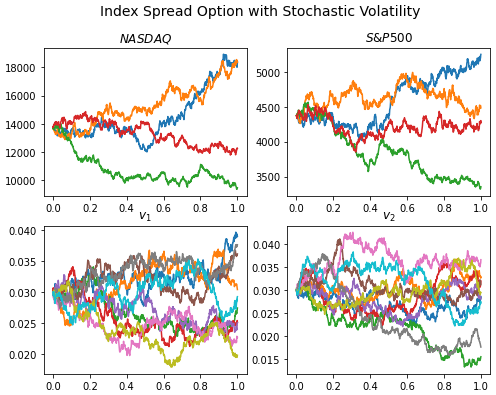European Spread Call Option with Stochastic Volatility
One of the main benefits of Monte Carlo simulations is to price options under multiple factors. By this I refer to multiple underlying asset prices or stochastic volatility or even changing interest rates.
In this tutorial we will explore the pricing of a European Spread Call Option on the difference between two stock indices \(S_1\) and \(S_2\) following a more general stochastic process. The SDE’s will be have stochastic volatility as described by the Heston Model (1993):
Underlying SDE’s under risk-neutral measure:
\(\large dS_{1,t} = (r-\delta_1) S_{1,t} dt + \sqrt{v_{1,t}} S_{1,t} dW^\mathbb{Q}_{1,t}\)
\(\large dS_{2,t} = (r-\delta_2) S_{2,t} dt + \sqrt{v_{2,t}} S_{2,t} dW^\mathbb{Q}_{2,t}\)
Variance Process:
\(\large dv_{1,t} = \kappa_1 (\theta_2 – v_{1,t})dt + \sigma_1 \sqrt{v_{1,t}} dW^\mathbb{Q}_{3,t}\)
\(\large dv_{2,t} = \kappa_2 (\theta_2 – v_{2,t})dt + \sigma_2 \sqrt{v_{2,t}} dW^\mathbb{Q}_{4,t}\)
The Monte Carlo procedure is exactly the same for a spread call option except the correlation matrix between Wiener processes is larger, as in we have four correlated normal variates to simulate the four processes.
Where:
\(\large \rho_{W^\mathbb{Q}} = \begin{vmatrix}1 & \rho_{12} & \rho_{13} & \rho_{14} \\ \rho_{12} & 1 & \rho_{23} & \rho_{24} \\ \rho_{13} & \rho_{23} & 1 & \rho_{34} \\ \rho_{14} & \rho_{24} & \rho_{34} & 1 \notag\end{vmatrix} \)
Notation:
– \(S_t\) Equity spot price, financial index
– \(v_t\) Variance.
– \(C\) European call option price.
– \(K\) Strike price.
– \(W_{1,2}\) Standard Brownian movements.
– \(r\) Interest rate.
– \(\delta\) discrete dividend payment
– \(\kappa\) Mean reversion rate.
– \(\theta\) Long run variance.
– \(v_0\) Initial variance.
– \(\sigma\) Volatility of variance.
– \(\rho\) Correlation parameter.
– \(t\) Current date.
– \(T\) Maturity date.
Example of Nasdaq vs S&P500 Index
A while back we discussed how to futures or options could be used to speculate on the divergence between the spread of the NASDAQ and S&P500 Indices. We follow on this example by incorperating stochastic volatility.
import numpy as np
from time import time
from scipy.linalg import cholesky
# Parameters - as of 1-Mar-22
SP500 = 4373.94
NASD = 13751.40
div_SP500 = 0.0127
div_NASD = 0.0126
K = 9377 # current difference between index points
T = 1
r = 0.01828 # 10yr US Treasury Bond Yield
# Heston Model Parameters - made up for the example,
# we have discussed how to complete this step in a previous video using market option prices
theta1 = 0.02
theta2 = 0.03
kappa1 = 0.1
kappa2 = 0.12
sigma1 = 0.05
sigma2 = 0.06
# initial variances
vt10 = 0.03
vt20 = 0.03
# Correlation matrix between wiener process under risk-neutral measure
rho = np.array([[1,0.5,0.15,0.02],
[0.5,1,0.01,0.25],
[0.15,0.01,1,0.2],
[0.02,0.25,0.2,1]])
Slow Implementation
Let’s first understand the implementation process
# Monte Carlo Specific Parameters
N = 100 # discrete time steps
M = 1000 # number of simulations
# Start Timer
start_time = time()
# Precompute constants
dt = T/N
# log normal prices
lnS1 = np.log(NASD)
lnS2 = np.log(SP500)
# Heston model adjustments for time steps
kappa1dt = kappa1*dt
kappa2dt = kappa2*dt
sigma1sdt = sigma1*np.sqrt(dt)
sigma2sdt = sigma2*np.sqrt(dt)
vt1 = vt10
vt2 = vt20
# Perform (lower) cholesky decomposition
lower_chol = cholesky(rho, lower=True)
# Standard Error Placeholders
sum_CT = 0
sum_CT2 = 0
# Monte Carlo Method
for i in range(M):
# for each simulation i in M
lnSt1 = lnS1
lnSt2 = lnS2
for j in range(N):
# for each time step j in N
# Generate correlated Wiener variables
Z = np.random.normal(0.0, 1.0, size=(4))
W = Z @ lower_chol
# Simulate variance processes
vt1 = vt1 + kappa1dt*(theta1 - vt1) + sigma1sdt*np.sqrt(vt1)*W[2]
vt2 = vt2 + kappa2dt*(theta2 - vt2) + sigma2sdt*np.sqrt(vt2)*W[3]
# Simulate log asset prices
nu1dt = (r - div_NASD - 0.5*vt1)*dt
nu2dt = (r - div_SP500 - 0.5*vt2)*dt
lnSt1 = lnSt1 + nu1dt + np.sqrt(vt1*dt)*W[0]
lnSt2 = lnSt2 + nu2dt + np.sqrt(vt2*dt)*W[1]
St1 = np.exp(lnSt1)
St2 = np.exp(lnSt2)
CT = max(0, (St1 - St2) - K)
sum_CT = sum_CT + CT
sum_CT2 = sum_CT2 + CT*CT
# Compute Expectation and SE
C0 = np.exp(-r*T)*sum_CT/M
sigma = np.sqrt( (sum_CT2 - sum_CT*sum_CT/M)*np.exp(-2*r*T) / (M-1) )
SE = sigma/np.sqrt(M)
print("Call value is ${0} with SE +/- {1}".format(np.round(C0,2),np.round(SE,2)))
print("Calculation time: {0} sec".format(round(time() - start_time,2)))
Fast Implementation
Vectorizing option pricing
# Monte Carlo Specific Parameters
N = 100 # discrete time steps
M = 1000 # number of simulations
# Start Timer
start_time = time()
# Precompute constants
dt = T/N
# Heston model adjustments for time steps
kappa1dt = kappa1*dt
kappa2dt = kappa2*dt
sigma1sdt = sigma1*np.sqrt(dt)
sigma2sdt = sigma2*np.sqrt(dt)
# Perform (lower) cholesky decomposition
lower_chol = cholesky(rho, lower=True)
# Generate correlated Wiener variables
Z = np.random.normal(0.0, 1.0, size=(N,M,4))
W = Z @ lower_chol
# arrays for storing prices and variances
lnSt1 = np.full(shape=(N+1,M), fill_value=np.log(NASD))
lnSt2 = np.full(shape=(N+1,M), fill_value=np.log(SP500))
vt1 = np.full(shape=(N+1,M), fill_value=vt10)
vt2 = np.full(shape=(N+1,M), fill_value=vt20)
for j in range(1,N+1):
# Simulate variance processes
vt1[j] = vt1[j-1] + kappa1dt*(theta1 - vt1[j-1]) + sigma1sdt*np.sqrt(vt1[j-1])*W[j-1,:,2]
vt2[j] = vt2[j-1] + kappa2dt*(theta2 - vt2[j-1]) + sigma2sdt*np.sqrt(vt2[j-1])*W[j-1,:,3]
# Simulate log asset prices
nu1dt = (r - div_NASD - 0.5*vt1[j])*dt
nu2dt = (r - div_SP500 - 0.5*vt2[j])*dt
lnSt1[j] = lnSt1[j-1] + nu1dt + np.sqrt(vt1[j]*dt)*W[j-1,:,0]
lnSt2[j] = lnSt2[j-1] + nu2dt + np.sqrt(vt2[j]*dt)*W[j-1,:,1]
St1 = np.exp(lnSt1)
St2 = np.exp(lnSt2)
# Compute Expectation and SE
CT = np.maximum(0, (St1[-1] - St2[-1]) - K)
C0 = np.exp(-r*T)*np.sum(CT)/M
sigma = np.sqrt( np.sum( (np.exp(-r*T)*CT - C0)**2) / (M-1) )
SE= sigma/np.sqrt(M)
print("Call value is ${0} with SE +/- {1}".format(np.round(C0,2),np.round(SE,2)))
print("Calculation time: {0} sec".format(round(time() - start_time,2)))
Visualisation
import matplotlib.pyplot as plt
t = np.linspace(0,1,len(St1))
fig, ax = plt.subplots(nrows=2, ncols=2, figsize=(8,6))
ax[0,0].plot(t,St1[:,:4])
ax[0,0].set_title('$NASDAQ$')
ax[0,1].plot(t,St2[:,:4])
ax[0,1].set_title('$S&P500$')
ax[1,0].plot(t,vt1[:,:10])
ax[1,0].set_title('$v_1$')
ax[1,1].plot(t,vt2[:,:10])
ax[1,1].set_title('$v_2$')
fig.suptitle("Index Spread Option with Stochastic Volatility", fontsize=14)
plt.show()

